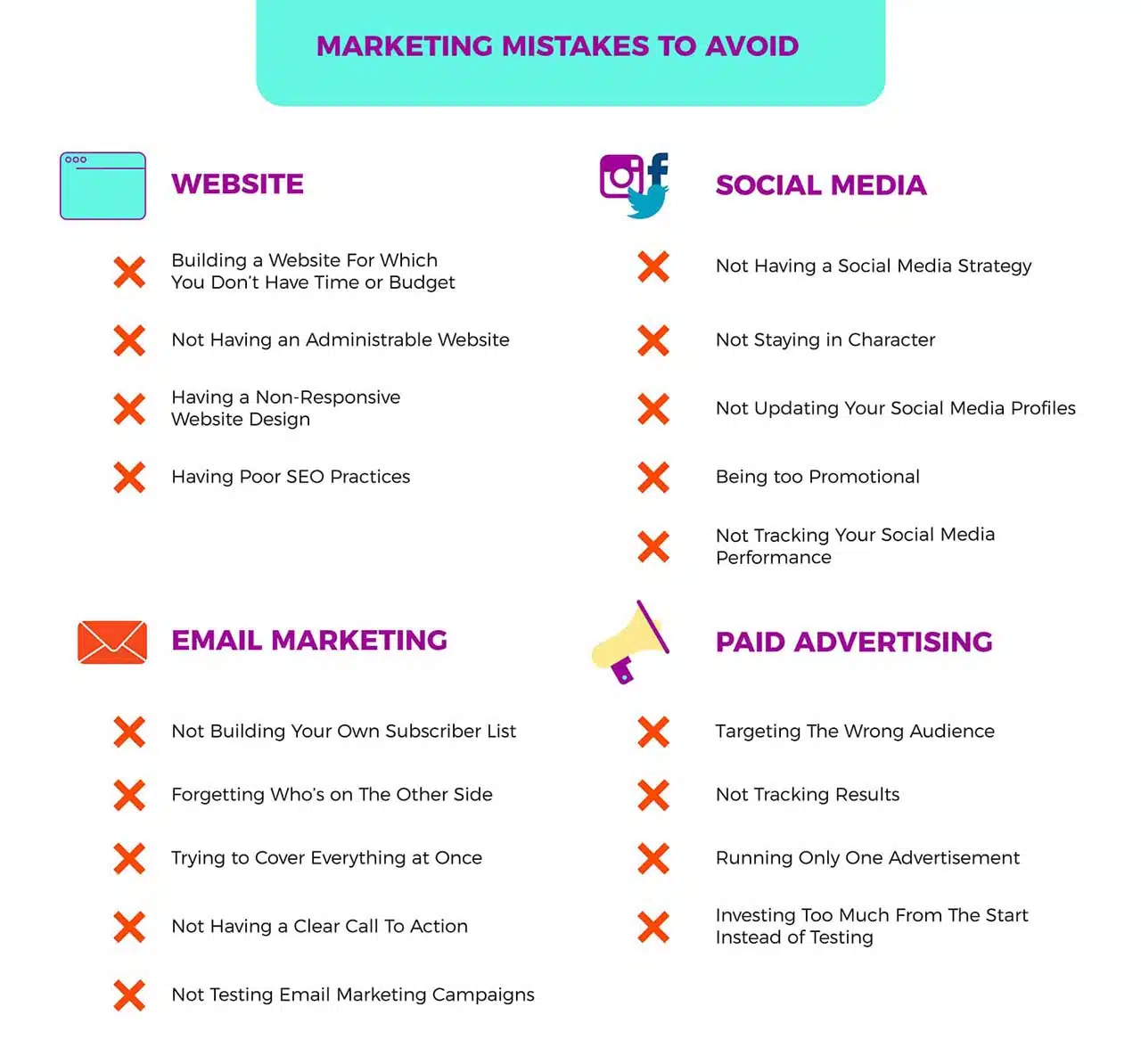Table of Contents
When you were planning to launch your own small business, you probably thought to yourself “it’s a jungle out there!” and maybe you were right.
Starting a new business isn’t easy, you must work hard and make sure that all areas are perfectly aligned to be able to achieve harmony – after all, any wrong turn can be costly. Sounds pretty straightforward, right? Well, the reality is that small businesses are, sometimes, in a hurry to get “the next big deal” or attract new customers (which is super valid by the way). However, quick results don’t necessarily translate into good results. That’s why some companies end up getting stuck with just another website, a few marketing activities that aren’t tied to a strategic plan, or even large email marketing campaigns that end up drowning the interest of the brand. Bottom line is that marketing mistakes are more common than you may think. Avoid them, and you’ll be able to maximize your investment.
Website-Related Mistakes
Did you know that about 95% of customers search online for products and services before making a purchase? Long story short, yes, you need some type of exposure but website strategies don’t have to be complicated. Having a website is really all about online presence, so find the tactic that best fits your company.
Building a Website For Which You Don’t Have Time or Budget
These days, a business without digital presence is losing half of their potential customers and pushing them to a competitor’s site. Thinking your business isn’t being searched for online is one of the most obvious mistakes but, more than that, don’t let the pressure of the digital world drive you to build a website that you may not have the budget or time for! It can be even more dangerous for your business than not having a website at all. If need be, take smaller steps. Here are some strategies small businesses can use to increase their online presence and generate customer conversions without a website:
- Social media accounts are a great way to start. They are free and you can start to build a strong brand.
- Landing pages. This option allows you to add a bit more information about your business than what you’re able to have on social media. You can have some optimized content to attract potential customers and awaken more interest for your brand.
Having a Non-Responsive Website Design
Not including mobile optimization when thinking about your website or landing page is another biggie. Most people open all pages on their smartphones; responsive websites allow visitors to view sites on the go, regardless of the screen size. Make sure to pick a responsive website design from the beginning because this is one of Google’s search ranking factors. If you don’t have a responsive site, it’s recommended to create the mobile version so you don’t lose half (or even more) of your visitors.
Not Having an Administrable Website
As a small business, you may not have a full time developer in your office, that’s why an administrable website will be an absolute must for your team. To be honest, not many people will deliver a non-administrable site nowadays but if someone is offering a “cheaper” option that doesn’t have an editable admin, it’s a big warning sign! Don’t think twice about investing a little more money on a good web designer from the beginning; you need to be sure your pages are editable to other people in your company. Being able to promptly update information like blogs, prices, and promotions will save you a lot of time and headaches.
Having Poor SEO Practices
If you’re having a hard time boosting traffic, this is probably the reason why. Unfortunately, there’s a very low chance anyone will be able to find your website if it lands anywhere other than the first page of a search. If you don’t want to be invisible, there are a few things you can do to optimize your website:
- Include keywords on every page of your site.
- Make sure each page has optimized titles and meta descriptions.
- Interlink your pages to similar topics or related products to make it easier for your visitors to navigate.
- Get other websites to link to your site.
- Add constant and optimized content.
Social Media Marketing Mistakes to avoid
Social networks are home to a large number of potential customers for different business areas. Hence, all companies are trying to build a strong social media presence to grow their lead numbers either in-house or through professional SMO services. However, developing a following and actually engaging with customers requires a bit of time and resources, which not all business owners are willing to invest in. Even if you are one to recognize the benefits of social media, unclear objectives and lack of expertise can be the 2 determining factors for your success.
Not Having a Social Media Strategy
You don’t want to end up wasting your precious time! Creating profiles and starting to share posts without having a defined social media strategy might actually be counterproductive for your company – you need to know what you’re doing on each network and why. To create a social media strategy, take into account the following steps:
- Research the competition.
- Design an action plan with smart goals.
- Create and curate social media content according to your brand.
- Identify your audience and research the social media networks they are on.
Not Staying in Character
Ensure your social presence is showing your brand in a coherent fashion. Think about your brand’s personality and align all your posts both graphically and in terms of tone of voice with the rest of your activities to establish brand recognition. Here a few steps you can’t ignore to be able to build your social media guidelines:
- Establish your brand’s tone of voice.
- Be consistent on all social media channels.
- Use the same graphic line in all social networks. It should also match your website and any other channels.
- Establish the format of your posts according to each social media profile: video, pictures, motivational quotes, blog posts, etc.
Not Updating Your Social Media Profiles
Many small businesses think it’s a great idea to open company profiles in all social networks to build a strong social media presence but they don’t add regular content on them and their profiles begin to die slowly. If that’s your case, it’s better not to open the profiles altogether because not updating them can affect the credibility of your business. Best practices recommend to create a content calendar according to your social media guidelines; it will help you avoid repeating the same content over and over again and, at the same time, define the content format you will use on each social media network. Note: this doesn’t mean you need to add content on every single network several times a day. Just be consistent with your postings and you’ll start seeing the growth!
Being too Promotional
Small businesses sometimes over-promote themselves not realizing that it will affect engagement rates. The best way to use your social media accounts is by creating customer-focused content to build brand awareness. Remember that social media platforms are designed to interact and engage with your audience through valuable content. It’s always helpful to keep in mind the 80/20 rule: 80% of your social media posts should inform, educate, and entertain while only 20% should directly promote your business.
Not Tracking Your Social Media Performance
Small business owners overlook the social media metrics that provide relevant information about the audience – they are very useful to consolidate and improve upon the marketing strategy. To track your social media metrics, it’s recommended to get your hands on a comprehensive tool that gives you complete reports in terms of performance, audience and other parameters.
Email Marketing Mistakes
Email marketing campaigns are a powerful way to drive traffic and boost your sales; actually, email marketing has one of the highest ROIs out there. In terms of investment, you’re looking at time and, maybe, a subscription to an email marketing tool. However, email marketing can be tricky in terms of workflows and timing, plus it does require a skillful writer to work on the copy and make it engaging. Make sure you avoid the most common email marketing mistakes, otherwise, you can end up killing new possible conversions before they even begin.
Not Building Your Own Database
In general, we don’t suggest buying an email list. When you send emails to contacts that have never heard of you, it lowers your chances greatly. Even if you’re trying to launch an outreach campaign, it’s better to do your own research to find the contact information. The best approach is to build your own database from scratch through marketing initiatives that catch the attention of your ideal customer. These are just some ways you could do so:
- High-converting landing pages.
- Collect leads through social media.
- Give free trials in exchange for personal data.
Forgetting Who’s on The Other Side
People love personalization! Making your emails more personal will increase engagement, even little things like including the contact’s name will boost your email rates. There are many tools available that take the contact information and allow you to make your emails hyper-personalized.
Trying to Cover Everything at Once
Monster emails will overwhelm your audience. As a new business, we know you have too much to say, but avoid having extra-long emails and just focus on the message. If you try to cover everything at once, you can lose your audience’s interest. If the topic is too broad, it’s better to send out several emails keeping them short and simple; this will make users want to read every single email right up to the end.
Not Having a Clear Call To Action
Email marketing campaigns require a clear call to action that directs the readers to take the action you want, otherwise, they won’t know where to click and may just skip right over it. Make sure to keep your CTA easy and simple, use bright colors and add action words like “Register Now”, “Reserve my Spot” and “Get my ebook”.
Not Testing Email Marketing Campaigns
A big marketing mistake small businesses make is to assume that the first campaign sent is the one that works best, failing the test and improve. Testing is the only way to know what works better for your business and the most common way to do so is through A/B testing. The latter consists of sending 2 variations of each email, one for a portion of your subscribers, and the other variation for the remaining portion. This approach will allow you to see which version generates the best results.
Advertising Don’ts
Ad campaigns are one of the marketing efforts that yield results the fastest, of course, when they are executed properly. If you’re just running ads because that’s what it’s expected, it may actually become a bottomless pit of money. Keep your eye on the price, identify your audience and build an advertising strategy that fits your budget as much as it does your brand.
Targeting The Wrong Audience
Businesses need to know who their ideal customer is. If you don’t know your audience, you will miss out on all the benefits of running targeted ads. To reach maximum results, it’s necessary to target your audience either by gender, country, education, or other specific criteria. Make sure you’re adding the proper parameters on each platform because targeting the wrong audience may bring in traffic but surely not conversions.
Not Tracking Results
Tracking your ads is key to know if your strategy is working effectively. If you don’t monitor your results, you will never know if each dollar you’re investing is returning or not. Stay tuned and calculate your ROI after each ad campaign. A few key metrics to help you get started:
- Where do most of your leads come from?
- What is your total website traffic?
- What is the conversion percentage per channel?
- What is the cost of each lead?
Running Only One Advertisement
New business owners often fall on this mistake. The key to a successful paid campaign is frequency and patience, placing a single ad campaign will help, but it won’t make any miracles. The solution here is to be consistent so you can keep your brand top of mind.
Investing Too Much From The Start Instead of Testing
Testing your ads will be the single most important thing you will be doing with them – you’ll need to be able to optimize impressions and click-through rates. With that said, if you start with a high budget, you’ll end up spending x amount of money on an ad that hasn’t yet been fully optimized – probably not the best strategy. It’s suggested to start off with a sound amount that allows you to test out your ad and start increasing from there. Identify any mistakes you are falling prey to? It’s ok! Life is about learning from your mistakes and trying to do better every day. To avoid any future errors, make sure you improve your marketing strategy in the best possible way for your business. If you’re looking to reach more customers and grow your business, take a look at our digital marketing ebook where you can find actionable marketing ideas for small businesses.







